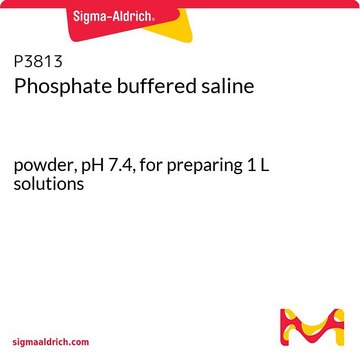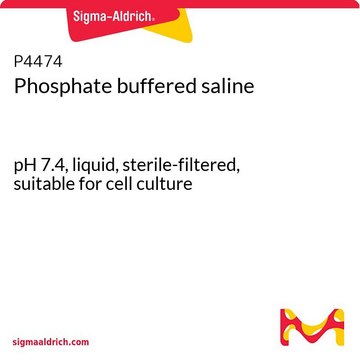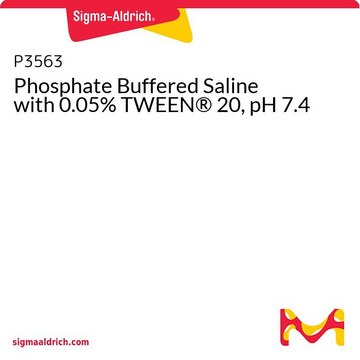P4417
Phosphate buffered saline
tablet, pH 7.2-7.6 (1 tablet/200 mL)
Synonym(s):
PBS
About This Item
Recommended Products
product name
Phosphate buffered saline, tablet
form
tablet
Quality Level
storage condition
dry at room temperature
color
white
pH
7.2-7.6 (1 tablet/200 mL)
solubility
water: soluble
density
1.02 g/cm3 at 20—25 °C
1.03 g/cm3 at 20—25 °C
application(s)
diagnostic assay manufacturing
histology
life science and biopharma
Looking for similar products? Visit Product Comparison Guide
Related Categories
General description
Expanding beyond cell biology, PBS demonstrates versatility in applications such as creating custom ELISA buffers for optimal antibody-antigen interactions. Moreover, it serves as a proficient running buffer for Protein A/G chromatography, facilitating antibody purification based on specific antigen binding. In hematological and biochemical procedures, PBS plays a pivotal role in the effective washing of cells and tissues. In summary, PBS stands out as an indispensable tool in both biological and biochemical research, offering isotonicity, buffering capacity, simplicity, and stability. Its diverse applications in cell biology, reagent preparation, protein purification, and various biological assays underscore its profound significance in advancing scientific knowledge and understanding.
Application
- for the production of platinum nanoparticles (NP-Pt) hydrocolloids
- for the washing of blood sample and SEM (scanning electron microscope) stubs prior to SEM
- for preparing the solution of fluorescent lectin wheat germ agglutinin (WGA)
- for the dilution of capture antibody during ELISA (enzyme linked immunosorbent assay)
- for suspension of cell pellets during centrifugation
- in immunoassay procedures
Features and Benefits
- High-quality product suitable for multiple research applications
- Can be used as a buffer component in biological and biochemical applications
- Highly soluble in water
Reconstitution
Other Notes
also commonly purchased with this product
recommended
Storage Class Code
13 - Non Combustible Solids
WGK
WGK 1
Flash Point(F)
Not applicable
Flash Point(C)
Not applicable
Certificates of Analysis (COA)
Search for Certificates of Analysis (COA) by entering the products Lot/Batch Number. Lot and Batch Numbers can be found on a product’s label following the words ‘Lot’ or ‘Batch’.
Already Own This Product?
Find documentation for the products that you have recently purchased in the Document Library.
Customers Also Viewed
Protocols
Antibody Purification using Protein A, Protein G, or Protein L Agarose protocol is designed as a quick purification method for antibodies from mammalian sera, ascites, and cell culture supernatants. It should be noted that if the starting material is serum or ascites the final preparation will contain endogenous host IgG as well as specific antibodies. In general, the presence of this endogenous IgG should not interfere with assays using the antibodies.
Cell staining can be divided into four steps: cell preparation, fixation, application of antibody, and evaluation.
ELISA protocols providing detailed instructions on performing indirect ELISA and Capture ELISA . Learn more about recommended products and techniques for performing both sandwich ELISA and indirect ELISA experiments.
To determine the molecular weights of protein antigens, to study protein/protein interactions, to determine specific enzymatic activity, to monitor protein post-translational modifications and to determine the presence and quantity of proteins.
Our team of scientists has experience in all areas of research including Life Science, Material Science, Chemical Synthesis, Chromatography, Analytical and many others.
Contact Technical Service









